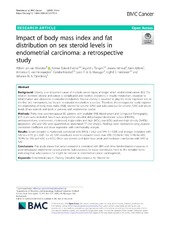| dc.contributor.author | van Weelden, Willem Jan | en_US |
| dc.contributor.author | Fasmer, Kristine Eldevik | en_US |
| dc.contributor.author | Tangen, Ingvild Løberg | en_US |
| dc.contributor.author | IntHout, Joanna | en_US |
| dc.contributor.author | Abbink, Karin | en_US |
| dc.contributor.author | van Herwaarden, Antonius E. | en_US |
| dc.contributor.author | Krakstad, Camilla | en_US |
| dc.contributor.author | Massuger, Leon F.A.G. | en_US |
| dc.contributor.author | Haldorsen, Ingfrid S. | en_US |
| dc.contributor.author | Pijnenborg, Johanna M.A. | en_US |
| dc.date.accessioned | 2020-05-11T15:45:42Z | |
| dc.date.available | 2020-05-11T15:45:42Z | |
| dc.date.issued | 2019-06-07 | |
| dc.Published | van Weelden WJ, Fasmer KE, Tangen IL, IntHout, Abbink, van Herwaarden AE, Krakstad C, Massuger LF, Haldorsen IS, Pijnenborg JM. Impact of body mass index and fat distribution on sex steroid levels in endometrial carcinoma: A retrospective study. BMC Cancer. 2019;19:547:1-8 | eng |
| dc.identifier.issn | 1471-2407 | |
| dc.identifier.uri | https://hdl.handle.net/1956/22190 | |
| dc.description.abstract | Background Obesity is an important cause of multiple cancer types, amongst which endometrial cancer (EC). The relation between obesity and cancer is complicated and involves alterations in insulin metabolism, response to inflammation and alterations in estradiol metabolism. Visceral obesity is assumed to play the most important role in the first two mechanisms, but its role in estradiol metabolism is unclear. Therefore, this retrospective study explores the relationship of body mass index (BMI), visceral fat volume (VAV) and subcutaneous fat volume (SAV) and serum levels of sex steroids and lipids in patients with endometrial cancer. Methods Thirty-nine postmenopausal EC patients with available BMI, blood serum and Computed Tomography (CT) scans were included. Serum was analyzed for estradiol, dehydroepiandrosterone sulfate (DHEAS), androstenedione, testosterone, cholesterol, triglycerides and high (HDL), low (LDL) and non-high density (NHDL) lipoprotein. VAV and SAV were quantified on abdominal CT scan images. Findings were interpreted using pearson correlation coefficient and linear regression with commonality analysis. Results Serum estradiol is moderately correlated with BMI (r = 0.62) and VAV (r = 0.58) and strongly correlated with SAV (r = 0.74) (p < 0.001 for all). SAV contributes more to estradiol levels than VAV (10.3% for SAV, 1.4% for VAV, 35.9% for SAV and VAV, p = 0.01). Other sex steroids and lipids have weak and moderate correlations with VAV or SAV. Conclusions This study shows that serum estradiol is correlated with BMI and other fat-distribution measures in postmenopausal endometrial cancer patients. Subcutaneous fat tissue contributes more to the estradiol levels indicating that subcutaneous fat might be relevant in endometrial cancer carcinogenesis. | en_US |
| dc.language.iso | eng | eng |
| dc.publisher | BMC | eng |
| dc.rights | Attribution CC BY | eng |
| dc.rights.uri | http://creativecommons.org/licenses/by/4.0/ | eng |
| dc.subject | Endometrial cancer | eng |
| dc.subject | Obesity | eng |
| dc.subject | Estradiol | eng |
| dc.subject | Subcutaneous fat | eng |
| dc.subject | Visceral fat | eng |
| dc.title | Impact of body mass index and fat distribution on sex steroid levels in endometrial carcinoma: A retrospective study | en_US |
| dc.type | Peer reviewed | |
| dc.type | Journal article | |
| dc.date.updated | 2019-12-13T12:15:04Z | |
| dc.description.version | publishedVersion | en_US |
| dc.rights.holder | Copyright 2019 The Author(s) | |
| dc.identifier.doi | https://doi.org/10.1186/s12885-019-5770-6 | |
| dc.identifier.cristin | 1715176 | |
| dc.source.journal | BMC Cancer | |
| dc.relation.project | Kreftforeningen: 190202 | |
| dc.relation.project | Norges forskningsråd: 273280 | |

